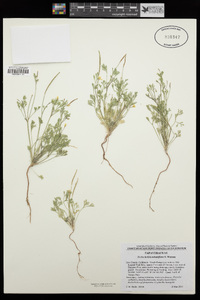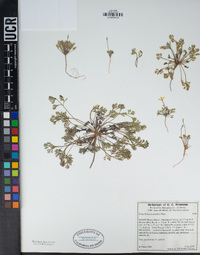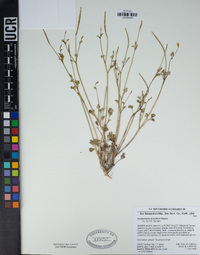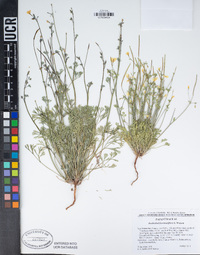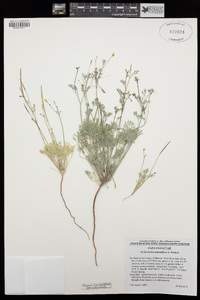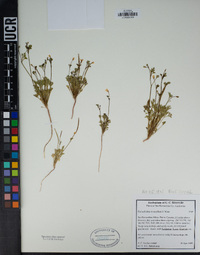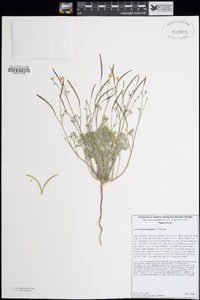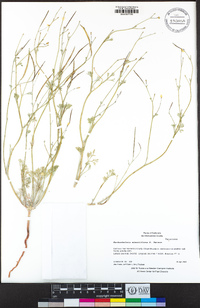Eschscholzia minutiflora
|
|
|
|
Family: Papaveraceae
Pygmy Golden-Poppy, more...pygmy poppy, pygmy goldenpoppy
[Eschscholtzia minutiflora Parish ex Greene] |
Plants annual, caulescent, erect or spreading, 5-35 cm. Leaves basal and cauline; blade grayish or bluish green, glabrous, glaucous; ultimate lobes usually obtuse, terminal broadened at apex. Inflorescences cymose or 1-flowered; buds nodding. Flowers: receptacle obconic, cup without spreading free rim; calyx acuminate, glabrous, sometimes glaucous; petals yellow, sometimes with orange spot at base, 3-26 mm. Capsules 3-6 cm. Seeds brown to black, ellipsoid, 1-1.4 mm, reticulate. 2 n = 12, 24, 36. Flowering late winter-spring (Mar-May). Desert washes, flats, and slopes; 0-2000 m; Ariz., Calif., Nev., Utah; nw Mexico. Eschscholzia minutiflora is highly variable in flower size. Typically, plants are hexaploid (2 n = 36) with petals 3-10 mm. Tetraploid plants (2 n = 24) with petals 6-18 mm, from the northern and central Mojave Desert of California, have been distinguished as subsp. covillei . Diploid plants (2 n = 12) with petals 10-26 mm, restricted to the El Paso and Rand mountains of the western Mojave Desert, have been distinguished as E . minutiflora subsp. twisselmannii and are considered to be of conservation concern; previously they were misattributed to E . parishii .
Plant: annual herb; 0.5-3.5 dm tall Leaves: basal and usually also cauline, the basal leaves at least twice as long as the cauline ones; leaves erect to spreading, glabrous, gray- or blue-glaucous; terminal leaf divisions obtuse, less than 2 mm long INFLORESCENCE: scapes or few- to many-flowered cymes Flowers: bud nodding, ellipsoid-ovoid, short-pointed; outer rim obsolete; inner rim erect, hyaline, less than 0.5 mm tall; sepals glabrous, sometimes glaucous, 4-6 mm long; petals yellow, 3-8 mm long Fruit: capsules 3-6 cm long, cylindric, dehiscent from base; SEEDS 1-1.4 mm wide, generally oblong to elliptic, net-ridged, brown to black Misc: Washes, flats, and slopes in Sonoran and Mojave Desert scrub, commonly in sandy soil; 200-1350 m (700-4400 ft); (Jan) Feb-May (fr. Mar-Jun) REFERENCES: Ownbey, Gerald B., Jeffrey W. Brasher, and Curtis Clark. 1998 Papaveraceae. J. Ariz. - Nev. Acad. Sci. 30(2): 120. FNA Vol. 3, Ownbey et al. 1998, Jepson 2012, Kearney and Peebles 1969 Duration: Annual Nativity: Native Lifeform: Forb/Herb General: Herbaceous annuals, to 35 cm tall, stems erect or spreading and branching, herbage glabrous, gray- or blue-glaucous. Leaves: Alternate, 1-4-pinnate-dissected, segments narrow and short, terminal lobes less than 2 mm long and broadened at the apices with obtuse tips, margins entire to shallowly notched, borne erect to spreading. Flowers: Small, yellow to orange, rarely white or pink, sometimes with an orange spot at the base, petals 4, free, obovate or wedge-shaped, 3-26 mm long, shedding after flowering and leaving the crown-like membrane of the inner receptacle rim exposed and erect, less than 0.5 mm tall, buds nodding, ellipsoid-ovoid, short-pointed, with glabrous to glaucous surfaces, sepals 2, fused, 4-6 mm long with glabrous or sometimes glaucous surfaces, shed as a unit at flowering, receptacles obconic, the tips cupped around the ovary base, stamens generally many, ovaries solitary, superior, with 1 chamber, styles absent or solitary, stigmas or lobes 2-many, ovules few to many, flowers borne in scapes or few- to many-flowered cymes. Fruits: Oblong or cylindric capsules 3-6 cm long, dehiscent from the base. Seeds 1-1.4 mm wide, generally oblong to elliptic, brown to black, surfaces net-ridged. Ecology: Found on sandy soils, in desert washes, on flats, slopes and Mohave or Sonoran desert scrub communities, from 650-8,500 ft (198-2591 m); flowering January-June. Distribution: Arizona, California, Nevada, Utah; Mexico. Ethnobotany: Specific uses for this species are unknown, but other species in the genus have uses; plant used as a sedative for babies, and pollen used by women as a facial cosmetic. Etymology: Eschscholzia is named after Dr. Johann Friedrich Gustav von Eschscholtz (1793-1831), a Latvian or Estonian surgeon, entomologist and botanist who came with the Russian expeditions to the Pacific coast in 1816 and 1824, and minutiflora means minute-flowered. Synonyms: None Editor: LCrumbacher2012 |









